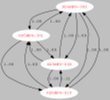TeamSpeak 3 and Broadband-Hamnet Meshed Networks
Hannes Coetzee, ZS6BZP, B.Eng. Electronic (Pretoria), M.Sc. Space Physics (Rhodes) and JP Coetzee, ZU6PJ
TeamSpeak 3 is a Voice over Internet Protocol (VoIP) application that is very popular in the online gaming fraternity [1]. It also has some very useful features for Amateur radio meshed network applications.
Introduction
It is a simple process to hack specific routers with new firmware, enabling the establishment of wide band, high speed; self-discovering, self-healing Amateur radio IP based networks [2]. These high speed networks can now be utilised for classical and some more advanced Amateur radio applications.
Radio Hams’ favourite pastime is to chat with fellow Hams and TeamSpeak 3 provides this functionality, as well as lots of others, on IP based networks. TeamSpeak 3 Voice Functionality Applicable to Amateur Radio
On a network there must be at least one TeamSpeak 3 server running while all the users (Hams) connect as clients. This client-server architecture is very common and fortunately easy to set up.
TeamSpeak 3 can then be configured to provide the following:
-
Public Channels. This is similar to a 2m or 70cm repeater where anybody can tune into the repeater (select the appropriate channel) and communicate through it. It is also possible to configure multiple Public Channels, providing the same functionality as a network or group of repeaters, each on its own frequency, which provides coverage of a town or metropolitan area.
-
Private Channels provide nearly the same functionality as you and your buddies’ favourite simplex FM channel, but probably over extended distances depending on the coverage offered by the meshed network.
TeamSpeak 3 differs in one important aspect from classic 2-way radio: It is full duplex and it allows multiple users to talk at the same time.
Push-to-Talk (PTT) is implemented in one of the following three ways and an operator can easily on the fly choose the best one for the applicable situation:
-
Live mic: The microphone is always on and the audio is continuously transmitted. Very useful in some emergency communications. In TeamSpeak 3 this is called “Continuous Transmission”.
-
VOX: Audio is only transmitted when spoken into the microphone. TeamSpeak 3 calls this “Voice Activation Detection”.
-
The other option is “Push-To-Talk” where a key on the keyboard, such as the spacebar, is assigned the PTT functionality.
Getting on the air and starting to chat away is as simple as selecting your favourite channel and giving your friends a call, similar to chatting on a 2m repeater. The only difference is the crystal clear audio only available through broadband digital networks.
TeamSpeak 3 Keyboard-to-Keyboard Chat
PSK-31 type keyboard-to-keyboard chat is also possible. An added benefit is that a message can be left even though the other Ham may not be at his computer at the time. On his return he’ll find it on his screen, very similar to the well-known “Skype” application.
TeamSpeak 3 File Transfer
It is a simple matter to send photos or any file to a selected person or persons. This is very useful during emergencies where a picture can tell a story of a thousand words or where a situation rapport must be delivered. Hamnet at its best!
Licensing and Costs
TeamSpeak 3 is free for non-commercial groups or individuals who wish to host a single server with up to 32 slots.
For larger groups a “Non-Profit” licence is available at no cost. This caters for up to two servers with up to 512 slots. The person hosting the server(s) needs to register and provide an active email address.
The above licencing options are very applicable to Broadband-Hamnet meshed network applications and should cater for the vast majority of requirements.
Installing TeamSpeak 3
TeamSpeak 3 can be found at www.teamspeak.com Click on “Downloads” and select the Client version applicable to your operating system.
Configuring TeamSpeak 3
A TeamSpeak 3 server must be installed (and running) on a computer forming part of the target network. The first TeamSpeak 3 client to connect to the newly installed server will receive an administrator token enabling him to define channels, privileges, permissions, etc. This person can decide to keep the token and thus be the administrator or it can be shared with other clients, allowing more than one person to be an administrator.
Connecting to the TeamSpeak 3 Server
Once your PC/laptop is connected to the meshed network, the TeamSpeak 3 client must be launched:
-
Double click on the TeamSpeak 3 icon on the desktop to launch the program.
-
Once TeamSpeak 3 has opened click on the Connections tab on the top left of the screen.
-
Click on the Connect button.
-
A Server Address: will be requested by the TeamSpeak 3 client. Enter the address of the node where the TeamSpeak 3 server is hosted, for example ZS6BZP-01-local.node.
-
Click on the Connect button and you are ready to speak to the world! OK, maybe not the whole world but at least everybody on your meshed network that has TeamSpeak 3 installed.
Conclusion
TeamSpeak 3 is ideally suited for the requirements of radio Hams making use of high speed meshed networks. Best of all, the price is just right.
Now you are speaking!
Handy Websites
-
www.teamspeak.com
-
http://broadband-hamnet.org/
|



